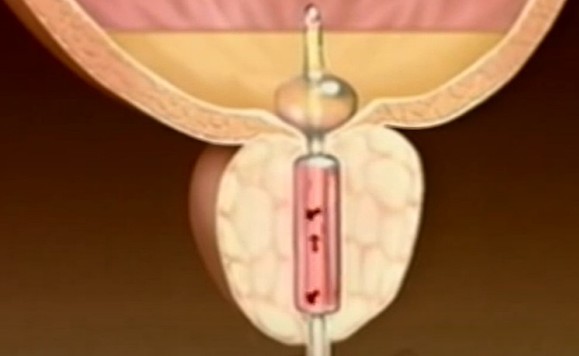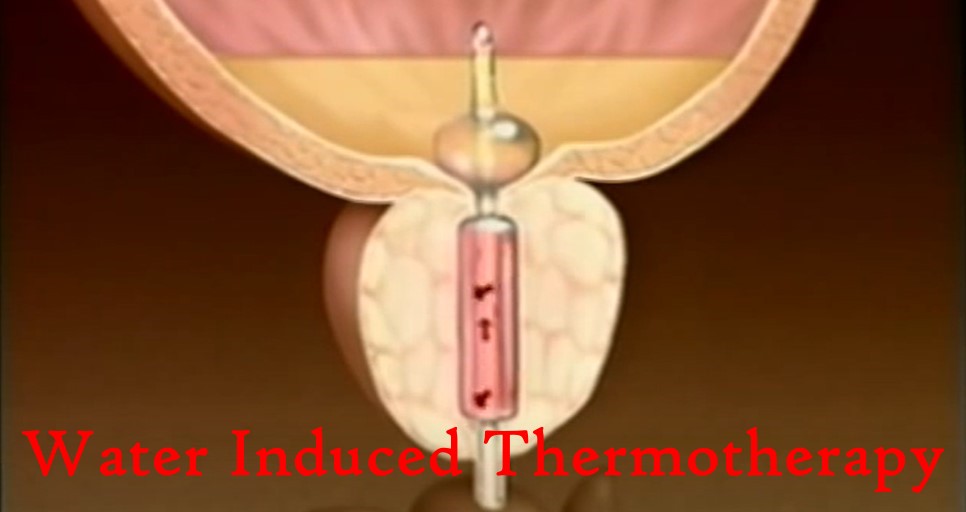Water-Induced Thermotherapy (WIT), uses hot water and was practiced before steam thermal therapies like REZUM: A modern approach to heat-based treatment
Water-induced thermotherapylike REZUM offer a minimally invasive solution for men suffering from benign prostatic hyperplasia (BPH). This innovative treatment uses heated water to reduce the size of an enlarged prostate, alleviating urinary symptoms without the need for major surgery. WIT achieves prostate tissue ablation through the application of hot water, causing coagulative necrosis and subsequent shrinkage of the gland.

The procedure involves a specialized catheter system that delivers heated water directly to the prostate. WIT uses Water heated to 60 degrees Celsius circulated through the closed-loop catheter, creating a thermal lesion in the prostate tissue. This targeted approach minimizes damage to surrounding structures while effectively addressing BPH symptoms. Note REZUM uses steam at 103 degrees Celsius in the same fashion for better results.
For men seeking alternatives to traditional surgical options, WIT presents an appealing choice. The outpatient nature of the procedure, combined with its low risk of side effects, makes it particularly suitable for patients with other health conditions who may not be ideal candidates for more invasive treatments.
Key Takeaways
- WIT uses heated water to shrink enlarged prostates and relieve BPH symptoms.
- REZUM is a form of WIT using steam instead of hot water
- The procedure is minimally invasive and typically performed on an outpatient basis.
- WIT offers a low-risk alternative to traditional surgical treatments for BPH.
Understanding Water-Induced Thermotherapy (WIT)
Water-induced thermotherapy is a minimally invasive technique for treating benign prostatic hyperplasia. It utilizes heated water to ablate excess prostatic tissue, improving urinary symptoms and quality of life for patients.
The WIT Procedure
Water-induced thermotherapy employs the Thermoflex System, consisting of an extracorporeal heat source and a closed-loop catheter system. A catheter with an inflatable treatment balloon is inserted into the prostatic urethra.
Water heated to 60°C circulates through the catheter, inflating the balloon and delivering thermal energy to the surrounding prostatic tissue. This controlled heat application causes tissue ablation.
The WIT procedure typically lasts 45-60 minutes and can be performed under local anesthesia. Patients may experience mild discomfort during treatment, but it is generally well-tolerated.
Note: REZUM is a more recent version of WIT. REZUM is a Water Vapor Therapy (uses steam instead of hot water).
A REZUM treatment typically lasts 10 to 15 minutes and can be performed as an outpatient procedure. The FDA approved REZUM in 2015.
Benefits and Advantages of WIT
WIT treatments offer several advantages over traditional surgical interventions. It is associated with fewer side effects and a quicker recovery time compared to transurethral resection of the prostate (TURP).
Patients often experience significant improvements in urinary symptoms, including reduced frequency, urgency, and nocturia. The procedure has minimal impact on sexual function, an important consideration for many patients.
WIT can be performed on an outpatient basis, reducing hospital stays and associated costs. It is suitable for patients who may not be candidates for more invasive procedures due to age or health conditions.
Comparative Analysis of WIT and Other Treatments
When compared to TURP, WIT shows comparable effectiveness in symptom relief with lower morbidity rates. However, TURP may provide more immediate and pronounced improvements in urinary flow.
WIT offers advantages over other minimally invasive techniques like transurethral microwave thermotherapy in terms of precision and control of thermal energy delivery. The Fast Liquid Ablation System, a variation of WIT, allows for even more rapid treatment times.
Prostatic artery embolization is another alternative, but WIT may be preferred for its direct approach to tissue ablation. Patient selection and individual factors play crucial roles in determining the most suitable treatment option.
Clinical Outcomes and Management
Note: the video below does not start until the 42 second mark.
Water-induced thermotherapy (WIT) offers a minimally invasive treatment option for benign prostatic hyperplasia. Its efficacy, potential complications, and post-treatment care are crucial aspects to consider when evaluating this procedure for patients with enlarged prostates and lower urinary tract symptoms.
Evaluating Treatment Efficacy
WIT’s effectiveness is primarily assessed through improvements in urinary symptoms and flow rates. The International Prostate Symptom Score (IPSS) serves as a key metric, typically showing significant reductions post-treatment. Peak urinary flow rates, measured by uroflowmetry, often increase by 2-4 ml/s on average.
Postvoid residual urine volume is another important indicator, with successful treatments resulting in decreased volumes. Studies have reported symptomatic improvement in 60-70% of patients within 3-6 months post-procedure.
Long-term efficacy data suggests sustained improvements for 2-3 years in many cases. However, some patients may require retreatment or alternative interventions if symptoms recur.
Potential Risks and Complications
While WIT is generally considered safe, it’s not without risks. Common adverse events include:
- Urinary tract infections (5-10% of cases)
- Temporary urinary retention (2-5%)
- Mild hematuria (3-7%)
More serious but rare complications can include:
- Urethral stricture (<1%)
- Incontinence (<1%)
- Retrograde ejaculation (2-4%)
Thermal injury to surrounding tissues is a potential risk, though modern equipment and techniques have minimized this concern. Coagulative necrosis of prostate tissue is the intended effect, but excessive necrosis can lead to complications.
Post-Treatment Care and Follow-Up
Immediate post-treatment care typically involves:
- Administration of antibiotics to prevent infection
- Use of a urethral catheter for 1-3 days
- Pain management with over-the-counter analgesics
Patients are usually advised to avoid strenuous activities for 1-2 weeks. Follow-up appointments are scheduled at regular intervals:
- 2 weeks post-procedure
- 3 months
- 6 months
- Annually thereafter
During these visits, IPSS, uroflowmetry, and postvoid residual volume measurements are repeated to assess ongoing treatment efficacy. Prostate-specific antigen (PSA) levels may also be monitored.
Patient education is crucial, emphasizing the gradual nature of symptomatic improvement and the importance of completing the full course of any prescribed medications. Any persistent or worsening symptoms should prompt immediate medical attention.
Frequently Asked Questions

Water-induced thermotherapy, particularly the Rezūm procedure, offers a minimally invasive treatment option for benign prostatic hyperplasia (BPH). Patients considering this therapy often have questions about its efficacy, costs, side effects, and recovery process.
What are the benefits and risks associated with Rezūm water vapor therapy?
Rezūm therapy provides relief from BPH symptoms with minimal invasiveness. Benefits include improved urinary flow and reduced prostate size. Risks are generally low but may include temporary urinary discomfort and urgency.
Some patients experience short-term retention requiring catheterization. Serious complications are rare.
How much does Rezūm treatment for BPH typically cost?
Rezūm treatment costs vary by location and insurance coverage. Without insurance, prices can range from $2,000 to $5,000. Many insurance plans cover part or all of the procedure.
Patients should consult their healthcare provider and insurance company for specific cost information.
What are common complaints or complications following a Rezum procedure?
Most patients report mild discomfort for a few days after the procedure. Common complaints include frequent urination, urgency, and burning sensations during urination.
These symptoms typically resolve within two to four weeks. Serious complications such as infection or bleeding are uncommon.
How does Rezūm compare with traditional treatments for enlarged prostate?
Rezūm offers several advantages over traditional BPH treatments. It is less invasive than surgical options like transurethral resection of the prostate (TURP).
The procedure preserves sexual function and has a quicker recovery time. It can be performed in an outpatient setting under local anesthesia.
What can be expected in terms of recovery after undergoing water vapor therapy?
Recovery from Rezūm is typically quick. Most patients return to normal activities within a few days. Urinary symptoms may worsen temporarily before improving.
Full symptom relief usually occurs within two to three months. Patients may need to use a catheter for a few days post-procedure.
Are there any long-term side effects associated with water-induced thermotherapy for prostate?
Long-term side effects of water-induced thermotherapy are generally minimal. The procedure does not typically affect sexual function or cause incontinence.
Some patients may require retreatment after several years. Ongoing research continues to evaluate the long-term efficacy and safety of this treatment approach.

